Archive for ‘Time Management’ Category
24 Smart Ways to Get More Organized and Productive in 2024
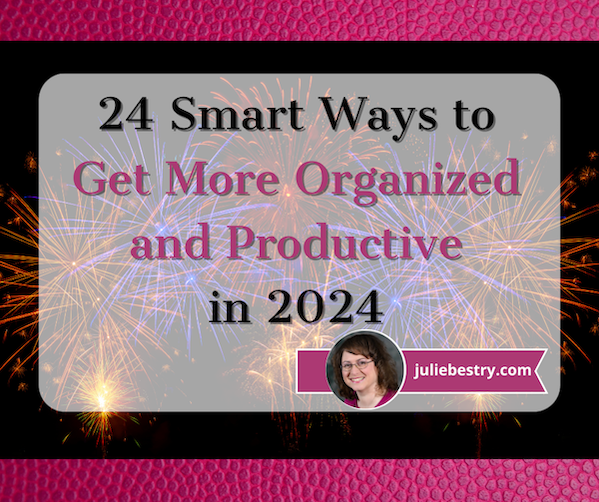
Happy New Year! Happy GO Month!
January is Get Organized & Be Productive (GO) Month, an annual initiative sponsored by the National Association of Productivity & Organizing Professionals (NAPO). We professional organizers and productivity experts celebrate how NAPO members work to improve the lives of our clients and audiences by helping create environments that support productivity, health, and well-being. What better way to start the year than creating systems and skills, spaces and attitudes — all to foster a better way of living?!

To start GO Month, today’s I’m echoing Gretchen Rubin’s 24 for ’24 theme that I mentioned recently, and offering you 24 ways to move yourself toward a more organized and productive life in 2024. There are 23 weekdays in January this year, so if you’re feeling aspirational and want to conquer all of these, you can even take the weekends off as the last item is a thinking task rather than a doing task.
I broke these organizing and productivity achievements down by category, but there’s no particular order in which you need to approach them, and certainly you don’t need to accomplish every one on the list, in January or even all year. Jump in and get started — some only take a few minutes.
PUT LAST YEAR AWAY
1) Make many happy returns!
Did you know that shoppers will return $173 billion in merchandise by the end of January? Chances are good that you (or someone for whom you oversee such things) got gifts that need to be returned.
Don’t put it off. The longer you wait, the more clutter will build up in your space, and the more likely you will be to suffer clutter-blindness until the return period has expired. Most stores have extended return policies during the holidays, but they can range upward from 30, depending on whether you have a gift receipt.
The Krazy Coupon Lady blog reviews the 2024 return deadlines for major retailers. She notes that you’ll get your refunds faster by returning items to the brick & mortar stores rather than shipping them back. You’ll also save money, because some online retailers charge a restocking fee.
2) Purge your holiday cards.
While tangible greeting are getting fewer and farther between, you probably still got a stack. Reread them one last time, and then LET THEM GO.

Did Hallmark or American Greetings do the heavy lifting, and the senders just signed their names? Toss them into the recycling bin. Paper Doll‘s grants you permission to only save cards with messages that are personal or resonant.
If they don’t make you cry, laugh, or go, “Ohhhhh,” don’t let them turn into the clutter you and your professional organizer will have to toss out years from now when you’re trying to downsize to a smaller home! It’s a holiday message, not a historical document; you don’t transcribe your holiday phone conversations and keep them forever, right?
The same goes for photos of other people’s families. You don’t have to be the curator of the museum of other people’s family history; let them do that.
3) Update your contacts.
Before you toss those cards, check the return addresses on the envelopes and update the information in your own contacts app, spreadsheet, or address book.
Next, delete the entries for people you’ll never contact again — that ex (who belongs in the past), that boss who used to call you about work stuff on weekends (ditto), people who are no longer in your life, and those who are no longer on this mortal coil.
If you don’t recognize the name of someone in your contacts, Google them or check LinkedIn (is it your mom’s doctor? your mechanic?) and if you still don’t know who it is, you’re obviously not going to be calling or texting them. Worst case scenario, if they text you, you can type back, “New phone, who dis?”
BOX UP YOUR INBOXES
4) Delete (most of) your old voicemails.
How often do you return a call only to hear, “The voicemail box is full and is not accepting messages. Please try again later.” When someone calls you and requests you call them back but their voicemail is full, it’s frustrating because it makes more labor for you.
Do you assume that it’s a cell phone and text them? (I believe texting strangers without permission is a breach of etiquette.) Plan to call back later? Assume that they’ll see the missed call and get back to you, starting another round of phone tag? ARGH!
Dial in to your voicemail and start deleting. Save phone numbers for anyone you’ll need to contact and log anything you may need to follow up on. But unless you’re saving a voicemail for legal purposes or because you can see yourself sitting in an airport, listening to a loved one’s message over and over (cue sappy rom-com music), delete old voicemails.
If you’ve got a landline, clear that voicemail. If you’ve still got an answering machine, how’s the weather in 1997? Yeah, delete old messages.
Smith.ai has a great blog post on how to download important voicemails (from a wide variety of phone platforms) to an audio file. Stop cluttering your voicemail inbox!
5) Clear Your Email Inboxes
Start by sorting your inbox by sender and deleting anything that’s advertising or old newsletters. If you haven’t acted on it by now, free yourself from inbox clutter! Delete! Then conquer email threads, like about picking meeting times (especially if those meetings were in the past).
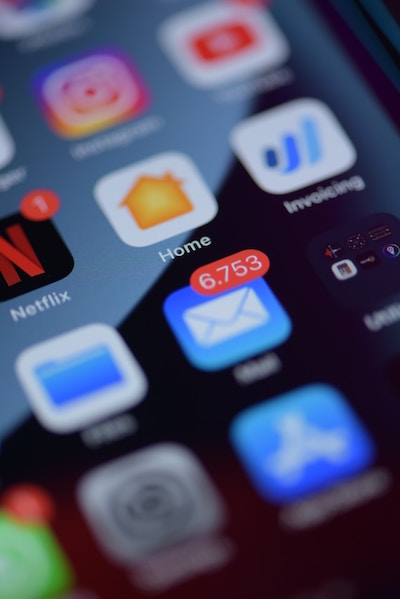
Take a few minutes at the end of each day to delete a chunk of old emails. To try a bolder approach, check out a classic Paper Doll post from 2009, A Different Kind of Bankruptcy, on how to declare email bankruptcy.
6) Purge all of your other tangible and digital inboxes.
Evernote has a default inbox; if you don’t designate into which folder a saved note should go, your note goes somewhere like Paper Doll‘s Default Folder. Lots of your note-taking and other project apps have default storage that serves as holding pens. Read through what you’ve collected — sort by date and focus on the recent items first — and either file in the right folders or hit delete!
Walk around your house or office and find all the places you tend to plop paper down. Get it in one pile. (Set aside anything you’ll absolutely need in the next few days to safeguard it.) Take 10 minutes a day to purge, sort, and file away those random pieces of paper so that you always know where they are.
HIT THE PAPER TRAIL
7) Embrace being a VIP about your VIPs.
You need your Very Important Papers for all sorts of Very Important Reasons. If the last few years have proven anything, it’s that life is unpredictable, so we need to find ways to make things as predictable and dependable as possible.
Yes, putting together essential paperwork isn’t fun. It’s boring. But you want it to be boring. The more boring your vital documents are, the more it means there will be no surprises for your loved ones in troubling times (like during and after an illness, after a death, while recovering possessions after a natural disaster) or even when you’re just trying to accomplish something like getting on an airplane.
Start with these posts, then make a list of any document you already have (and where it is), and another list of what you need to create, and plan meetings with your family and a trusted advisor to set things in motion.
How to Replace and Organize 7 Essential Government Documents
How to Create, Organize, and Safeguard 5 Essential Legal and Estate Documents
The Professor and Mary Ann: 8 Other Essential Documents You Need To Create
Paper Doll’s Ultimate Guide to Getting a Document Notarized
Paper Doll’s Ultimate Guide to Legally Changing Your Name
A New VIP: A Form You Didn’t Know You Needed
8) Create your tax prep folder now so you’ll be ready for April 15th.
Do you toss non-urgent mail on top of the microwave? Might those important 1099s and 1098s and 1095-A and W-2s get lost? Don’t lose deductions, pay more taxes, or get in trouble with the IRS!
By the end of January, you’ll start getting tax documents in the mail. Pop them in a folder in your financial files or in a dedicated holder like the Smead All-in-One Income Tax Organizer.
3 Simple But Powerful Productivity Resources — Right in Your Browser Tab
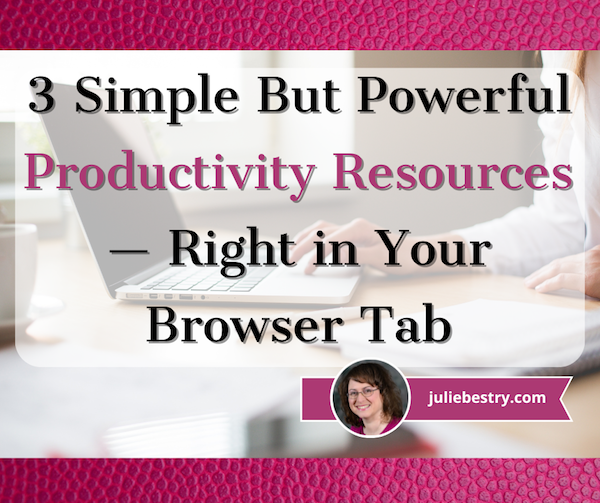
Too many open tabs cause stress and decrease your productivity. But what if you could boost your productivity right from your browser tab?
HOW TO BE A GOOD GOBLIN
For most of us above a certain age, the word “goblin” means a mischievous troll or gnome-like fictional creature, or perhaps the supervillain Green Goblin. However, younger Millennials and GenZ have coined an alternate meaning of the term as a “type of behavior which is unapologetically self-indulgent, lazy, slovenly, or greedy, typically in a way that rejects social norms or expectations.”
You’ll most often hear this in regard to someone saying they are operating in “goblin mode,” a term that became Oxford Language’s 2022 word of the year, a status designated as one that captures “the ethos, mood, or preoccupations of the past twelve months!”
The concept of goblin mode was that as everyone was coming out from hiding after the initial shutdown period in the pandemic, people were increasingly turning their back on expectations to return to the former status quo of overwork and social media-curated appearances of perfection.
Aside from a focus on eating comfort foods and living in cozy clothes, there’s an aspect of goblin mode that calls for finding hacks to make life and work less stressful or toxic. It was in researching the term that I originally found this first intriguing web site.

Goblin.Tools is a free suite of simple, browser-based, single-task tools. (If you’d prefer to use Goblin.Tools as a mobile app rather than in your browser, it’s also available for iOS and Android for $0.99, and you can install it as web app to use on a computer, outside of your browser.) It was created by Bram De Buyser, a Belgian freelance software engineer and cloud architect.
In terms of aesthetics, it’s bare-bones except for offering a dark mode option — just toggle between sun and moon icons — but when you’re aiming for productivity, keeping distracting features at bay is a plus!
Originally, Goblin.Tools was designed to help neurodivergent people with tasks that they found overwhelming or difficult, and it has become a go-to resource among younger people with autism and ADHD. However, over the course of this year, it caught the attention of so many mainstream newsletters and blogs that it seemed like I was getting almost daily news about it, and colleagues, including Hazel Thornton, were spreading the word.
While it’s particularly designed to assist people who are neurodiverse, it seems like it’s appropriate for anyone overwhelmed by various “adulting” tasks and the emotional load of accomplishing them.
Goblin.Tools uses artificial intelligence (currently backed by OpenAI‘s models), but you don’t need to understand how AI works to make use of them; if you know how to type and use Google, you’ll feel right at home. (If OpenAI sounds familiar, it’s because it’s the company that developed ChatGPT.)
That said, as with everything in AI (just like with most things you read on the internet), take the advice with a grain of salt. (For a hint as to why, read Hazel’s An “Interview” with ChatGPT in which I have a cameo.)
Goblin.Tools currently has six tools:
Magic ToDo
Magic ToDo starts out like typical to-do list, but it’s designed to conquer your overwhelm by breaking down a project into smaller tasks. A huge source of overwhelm when facing a project, whether large (finding a new job, writing a term paper, buying a house) or comparatively small (making dinner, cleaning the house) is translating the size and vagueness into distinct tasks.
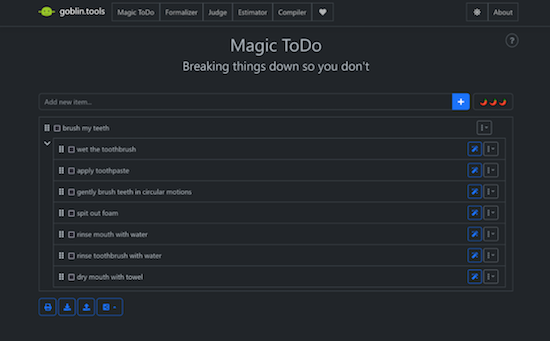
Magic ToDo in Dark Mode in iOS
- Type (or dictate) a task in the “Add new item” box, and click on the plus sign, and the AI breaks down your one entry into many steps without any input from you.
- Click on the magic wand icon associated with any step, and it similarly breaks that step or task down into smaller tasks. Lather, rinse, repeat.
- Click on the three-dot/arrow-down button for any task line and it gives you the options to estimate the time the task will take. Often, fear of the enormity of a task keeps people from getting started, but a simple reality check can make each step less daunting.
The three-dot/arrow-down button also lets you edit the words used to describe the task. This is great for customizing names, contexts, project titles, etc., so that you can take Goblin.Tools’ Magic ToDo suggestions and build on them to create the level of specificity that provides the clarity — and the activation energy — you require to get started.
Additionally, from this button, you can manually add subtasks (in case the AI doesn’t know everything you need to do) or delete an entire task if you realize it’s not necessary. If you start to edit a line, you’ll be supplied with two more icons: approve the changes by clicking the green check; cancel by clicking the red X.
The whole app is so simple and intuitive that it took you longer to read those last few paragraphs than it will to feel completely at ease using the features.
I simply wrote “Write a blog post” and Magic ToDo provided the rest.
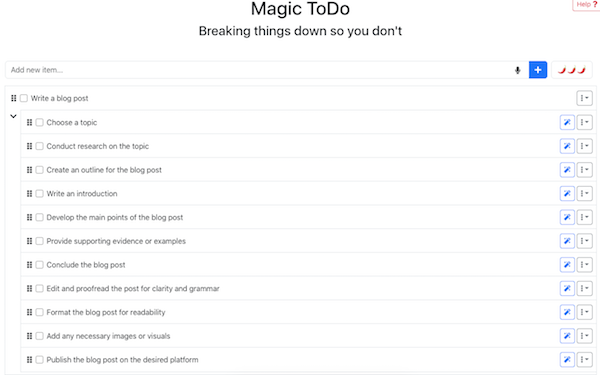
Magic ToDo in Light Mode in the Browser
- On the top item line, you’ll see three hot peppers ???. Clicking that icon reveals a sliding “spiciness” scale to allow you to tell the tool how hard or stressful you find the task. The spicier the task, the more baby-steps into which the tool will attempt to break it.
- Expand or collapse top level tasks by clicking an arrow to the left of the first sub-task. Mark a top-level task or sub-task complete by clicking the check box next to the title.
- Re-order top-level tasks or individual tasks sub-tasks by dragging and dropping the “column of dots” icon.
Below your whole to-do list are global-acton icons for dealing with all of your top-level tasks and subtasks. On the left side, the Sync button (still an experimental feature) allows you to log in and synchronize across your devices, and the Share button lets you save to an already existing file, upload a file, copy to a clipboard, print, or export to either a ToDoist or iCal file.
On the lower right, the Filter feature lets you filter one or more categories or hide all completed items. There are undo and re-do icons in case you make a booboo, and the hammer icon allows you to make global changes to all of your lists, like estimating all tasks or clearing all estimates, marking all tasks as not yet completed, clearing all completed tasks, and clearing all of your tasks entirely.
Formalizer
Formalizer rephrases whatever text you write and restates it in the style most appropriate for your audience (your 72-year-old Grandpa, your Lieutenant Colonel, your teen daughter, your evil boss) without changing the meaning. The style options are:
- more professional
- more polite
- less snarky
- easier to read
- more formal
- more informal
- more sociable (waffle)
- more to the point (unwaffle)
- less emotional
- more passionate
- more sarcastic
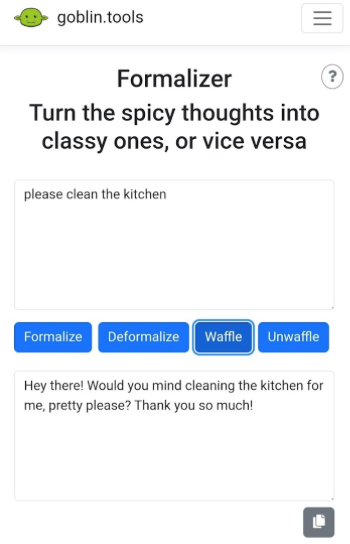
Formalizer in Light Mode in iOS
You can also set it to rewrite your text in bullet points, and you can even choose to highlight and change a single word in Thesaurus Mode, in case the issue isn’t your whole message but just one troubling word.
As with Magic To Do, there’s a spiciness setting to help the AI understand the gradation of how much text to be written in a particular style.
You can repeatedly hit the “Convert” button to achieve the response you want. Once it’s perfect, click the icon at the bottom right to copy the text to a clipboard and paste it into your text, email, schoolwork, or report.
Let’s say I’m a harried parent, just trying to get my teens or far-flung college kids or recent grads to take Thanksgiving festivities a little more seriously:
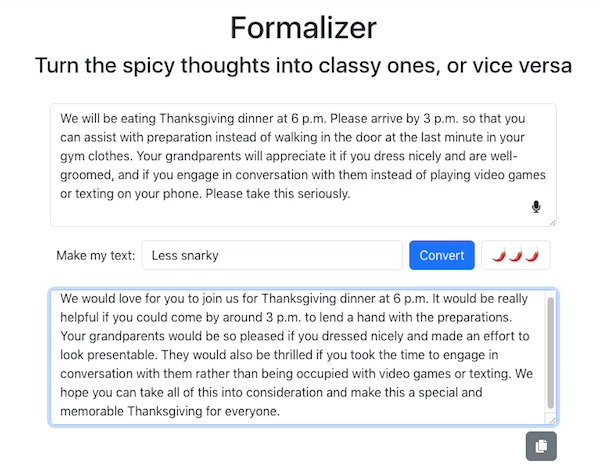
Formalizer in Light Mode in the Browser
This is a great tool for GenZ folks who tend to write in text-speak but want to communicate in a more adult way to professors or supervisors. Similarly, if you’re a Boomer teacher with a class full of GenAlpha tweeners, this might help you better connect with them.
Judge
Have you ever received a text from someone and not been able to tell from the tone whether the writer is being a rhymes-with-witch or is just being briskly straight to the point? Judge is designed to help the user figure out the emotional content of a piece of text to see how it would be perceived by a neutral party. (Maybe your mother-in-law is being a rhyme-with-witch, but both your spouse and your BFF are likely to be biased.)
Copy a block of text into the Judge tool, click “Judge” and it will evaluate the actual words and formality of the text to help determine the author’s tonal intent.
While this is intended to help neuro-diverse users better qualify “tone,” I sense that AI is most likely to under-deliver here. Neurotypical friends and family members may use teasing and slang in a way that the Judge feature considers rude and disrespectful, not recognizing that a writer may use formal language but be passive-aggressive.
Estimator
Subtitled “Just tell me how long this is probably gonna take,” this feature is available as a stand-alone or as part of Magic ToDo.
Type or dictate your task, add the “spiciness” to tell the AI how hard it will be for you to focus or how physically difficult the task is, and it will estimate how long the task should take. When you have a sense of how long a task really will take, you may be less likely to procrastinate on beginning.
If the task looms too large, head over to the Magic ToDo section to get help breaking the task down into smaller bites.
Compiler
If the Magic ToDo requires too much thinking and planning for you, the Compiler is a cheat sheet. The section is subtitled, “Compile my braindump into a list of tasks” and you literally just write down (or dictate) whatever’s on your mind.
As with all of the elements of the Goblin.Tools suite, you can type or dictate, but here’s where just unhinging your jaw and saying whatever comes to mind is best. Look around your room or your desk and just start saying whatever you remember you have to do (or pretend you’re leaving a rambling voicemail for your best friend), and then click “Turn into tasks.” Through the magic of AI, the app knows to focus on the actions verbs and creates a bullet (though unsortable) list.
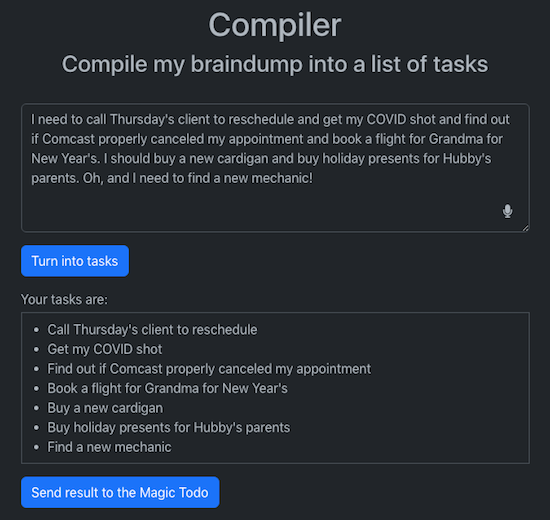
Compiler in Dark Mode in Browser
At the bottom, click “Send Result to the Magic ToDo” and with a few clicks (and without having typed anything), you now have a fleshed out to-do list that you can drag-and-drop to sort and ease your motivation.
The Chef
There are all sorts of apps into which you can list off the ingredients you have on hand and have it spit out recipes; I covered a bunch of them in Calm Cooking Chaos (Part 3): Organize With Recipe Apps, and even Google can do it.
However, this is fast and painless — and on-task for someone overwhelmed by adulting and already using Goblin.Tools.
List your available ingredients, but you can also mention any dietary constraints (vegetarian, vegan, diabetic, low-sodium, etc.), the number of portions or serving sizes you want, the equipment options (are you a no-oven college student? an all-the-gadgets suburbanite?), and the time you have available. Click the “Suggest” button and it’ll give you just one recipe (so as not to overwhelm you).
I don’t cook much (or well), so the ingredients in my kitchen are pretty random, but after I took two minutes to type the things most people would recognize as meal ingredients, Goblin.Tools invented a recipe for a creamy Italian pasta salad that I could (and would) actually make!
The Chef results can also be sent to Magic ToDo at the click of a button for those needing step-by-step cooking support.
If you know (or are) someone who gets overwhelmed by tasks or spends too much time trying to differentiate tone, Goblin.Tools is definitely worth checking out.
FOCUS ON WHAT’S HAPPENING RIGHT NOW
Right Now is barely what you could call an app. It’s a big, almost-blank, page in your browser designed to keep you focused on what you’re supposed to be doing right now.
Developed by Charlie Park, it reminds me of what I heard Alan P. Brown of ADD Crusher say at a NAPO conference years ago: “There are only three things. There’s what I’m doing now. There’s important stuff that’s not what I’m doing now. And there’s BS that’s not what I’m doing now.”
Park’s Right Now is for reminding you of what you are supposed to be doing right now when you are tempted to distract yourself at the computer.
When you go to the Right Now page, in large letters at the top, it says, “Right now:” in almost 3/4-inch-high black type. Then there’s a huge expanse of white space in which you write whatever it is you’re supposed to be doing.
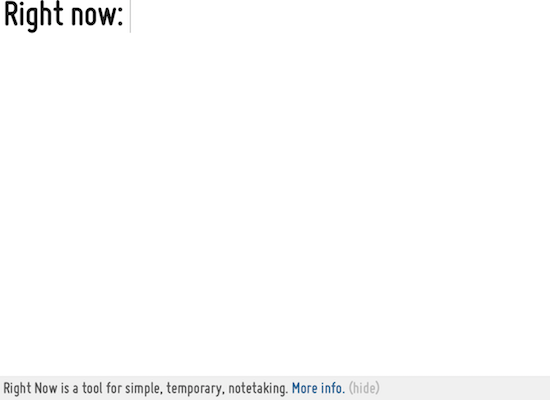
There’s no formatting; you can’t change the font or font size, or make your text bold or italics, or highlight anything in a different color. (You can, at least on a Mac, click Command-Z to undo.) But the thing is, it doesn’t really matter what it looks like ON the page. That’s because Right Now takes those initial words you’ve written and puts it in the browser tab.
Sure, you can use the page as a place to outline what you want to be working on, just as you could do on a piece of paper or in Evernote. The whole page is available to you, and you can scroll downward pretty much continuously. Write your Great American Novel in the window, if you like.
But the point is the browser TAB. When you get distracted on the web and go to click the plus sign to do something in a new tab, or you click on a link in a web page or document and it pops open a new browser tab, your eye will naturally be drawn upward to the tabs.
And you’ll see, in the Right Now tab, not the URL charliepark.org/rightnow, but the words YOU typed regarding what you’re supposed to be doing. The browser tab label will update dynamically with whatever you write at the top of the Right Now page, so you’ll immediately see what you’ve written to yourself. So, when I write at the top of Right Now:
![]()
my tab goes from:
![]()
to:
![]()
So, the smart thing is that whatever you decide to write on Right Now, definitely make the first words actionable, in verb-noun form. Like, “Research hotels” or “Write History Paper.”
The minute you get distracted on the web, you’ll look up to the tab line, see what you’re supposed to be doing RIGHT NOW and you’ll do that wow-I-coulda-had-a-V8 smack and get back to work.
At the bottom of of the page, it says, “Right Now is a tool for simple, temporary, notetaking” and there’s a link to a pop-up for how it’s supposed to work. You can click “(hide)” to make this bottom-of-the-page material disappear; as far as I can tell, the only way to bring it back is to reload the browser page.
Park cautions that notes will not be saved. However, I found that refreshing the page keeps my notes as written, as did closing the app in the browser and then opening it again. Opening in a different browser (say, Chrome vs. Safari) gave me a fresh screen. Your mileage may vary.
Right Now is free; just pull it up in your browser and close the tab when you’re done.
CALM YOURSELF WHEN YOU HAVE TOO MANY OPEN TABS
What’s your default “Home” tab in your browser, the one that opens when you go to a new tab? Is it a search engine? A social media site? A news provider? When you’re working, does your Home tab ever distract you?
CalmTab turns your browser’s “new tab” page into a two-fold productivity tool.
On the left half of the screen, there’s a Zen breathing box. A tiny green ball works its way slowly in a clockwise fashion around the curve-cornered box.
Meanwhile, in the center of the box, timed to move in concert with the exterior ball reaching each corner, a larger green ball gently nudges the participant to inhale, hold, exhale, and hold.
The larger center ball increases and decreases in size as you inhale or exhale (as the smaller ball moves along the horizontal planes of the box) and maintains size when you are to hold your breath (as the smaller ball moves along the vertical planes of the box).
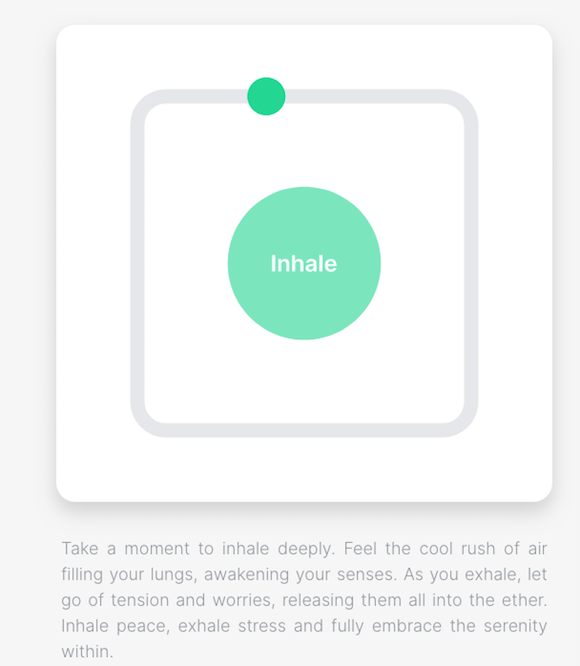
On the right side of the screen, there’s a Pomodoro-like time tracker (though you are not limited to a strict 25-minute Pomodoro).
- Type a task and state how long you want to work on it.
- Click the plus sign to lock the task in, and the task (again, think: verb-noun) will appear at the top of the element, with the amount of time you’ve scheduled to work on it listed below. Add as many tasks as you want, but only the one you’re focused on right now will be listed at the top. Calm Tab will list the total time you’ve made available to work on your tasks down below the three action-oriented buttons.
- Click the button with the white arrow (like a “play” button on a video) to start the counter and get to work. Once you’re working, it turns to a pause button (though, strictly speaking Pomodoro rules say you have to go back to the start if you’re interrupted during a Pomodoro).
- Click the refresh button to give yourself another round (of the same duration for that same task).
- Click the checkbox to tell Calm Tab you’ve completed the task, and it will move to the next item in line.
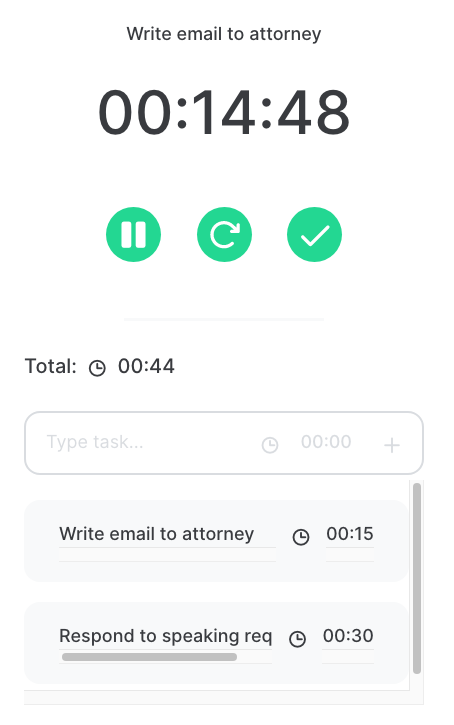
When you’ve completed a task, Calm Tab strikes through the words the task, but you can also click an X to delete it from your list, either as you go, or at the end of your work block.
There are three minimalist global controls at the top of the page. Click to toggle the audio alert (when you’re time’s up) on or off, and toggle the sun or moon to switch from light to dark mode.
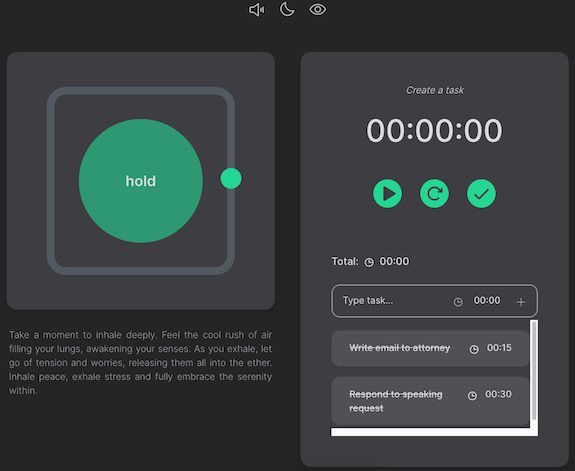
There’s also an eye icon; by default, the eye is open and you see the entire page as shown above. Click to close the eye, and tab goes blank except for the three icons at the top. This prevents being distracted by the breathing motion of the left side of the screen and the countdown timer on the right. Toggling the display off also protects your task list from prying eyes.
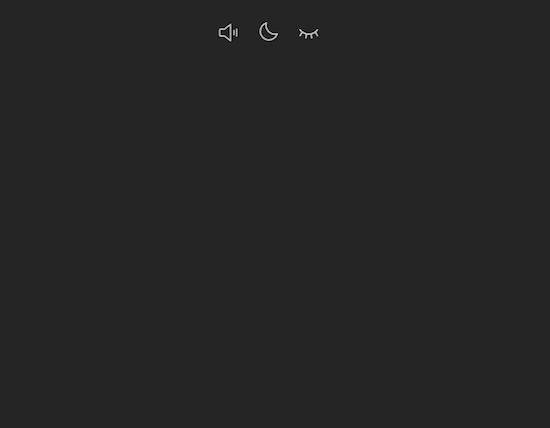
You can install Calm Tab on an unlimited number of devices. As long as you’re logged into your Google account (or whatever Google account you’ve used when installing the Chrome doohickey), you’ll have it available.
Calm Tab’s developer, Pere Ayats, is working on other features for the future, including a website blocker (to help maintain concentration), a bookmarks manager, a minimalist habit tracker, and simple usage analytics (to help you identify your work patterns and distraction tendencies).
The Calm Tab extension is free, but only available for Chrome. (Of course, this means you have to know how to add an extension to your Chrome set-up.)
I wish you could customize Calm Tab’s color scheme. I don’t love green (though it’s more appealing in dark mode), and would love to be able to select my own color.
Though I’m more of a Safari user, on high-stress at-my-desk days, I’ve found myself really appreciating Calm Tab’s Zen breathing box.
I’m a huge fan of free productivity resources that work right in the browser. Would you try any of these? Do you have any similar recommendations?
Take a Break for Productivity — The International Perspective
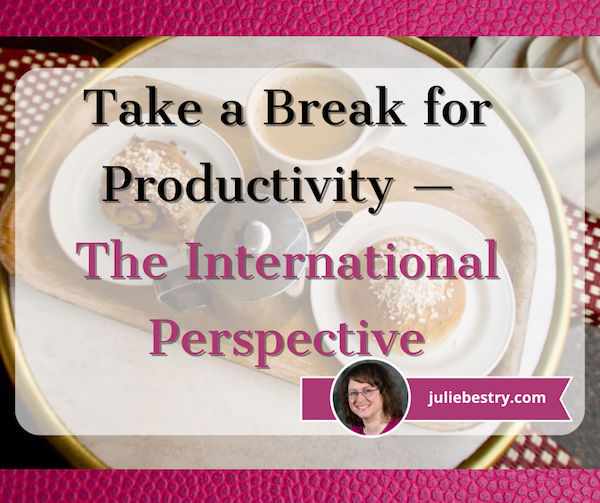
RECAPPING THE IMPORTANCE OF TAKING A BREAK
Last week, in Take a Break — How Breaks Improve Health and Productivity, we looked at the key benefits of taking breaks in helping us improve our mental and physical well-being as well as achieve our goals. These included:
- Enhanced physical health
- Reduced stress
- Increased energy and motivation
- Improved focus, memory, and concentration
- Prevention of decision fatigue
- Enhanced creativity and problem-solving
We also examined the various durations of breaks and their relative advantages for different purposes, from the teeny 20–20–20 breaks to prevent eyestrain (every 20 minutes of screen time, look away from the screen and focus on something at least 20 feet away for at least 20 seconds) to the quick breaks as we transition between meetings or tasks.
We looked extensively at the medium-length work breaks we often fail to indulge in (but need so much to refresh our bodies, brains, and spirits). Breaks benefiting the body include time taken for meals and snacks, resting and napping, walking, and even dancing, while pauses that improve mental function and emotional well-being include meditation or mindfulness, time spent in nature, and breaks for doing creative things, appreciating some aspect of life or culture, and socializing.
And, of course, breaks extend all the way to full vacations.
A SIDEBAR (SIDE TRIP?) FOR VACATIONS
Did you know that the longer a vacation is, the better it is for you, but only up to a certain duration? The average American worker is entitled to about 16 days of paid leave (combining holiday and vacation days), though we should note that about a quarter of workers get no paid leave at all!
Americans have a habit of trying glom vacation days onto long holiday weekends to try to pack month’s worth of need rest and relaxation into four days. While any break break is better than none, such short vacations fail to provide substantive recuperative benefits. Worse, according to a Pew Research Center Survey, 46% of U.S. workers who do get paid time off take less than they are allowed.
The reasons for workers shorting themselves time off vary and overlap: 52% don’t recognize the need, 49% worry that they will fall behind (and reap negative repercussions, including angering supervisors, risking their prospects for advancement (or even risking their jobs), and 43% feel guilty about their workload having to be handled by co-workers taking on additional work.
With all of these reasons not to take vacation, the counter-argument is obvious in the Harvard Business Review piece, You’re Never Going to Be “Caught Up” At work. Stop Feeling Guilty About It. Work keeps coming!
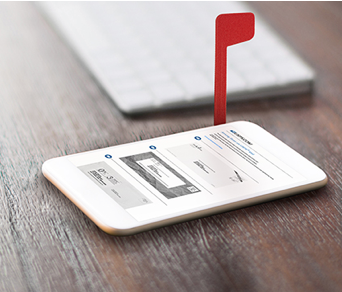 © United States Postal Service
© United States Postal Service
I always tell my clients that not only is Inbox: Zero largely a fallacy, so is Laundry Basket: Zero. Unless you decide to stop sending email or your family members all become nudists, it all keeps coming. We’re humans, not robots, and can do only so much. So, as the article says, we must practice self-compassion, focus on our accomplishments rather than our shortfalls, and use mindfulness.
Don’t guilt yourself into trying to accomplish an inhumane amount of work, and go back to last week’s post to see why you need to take breaks!
Finally, the Pew study didn’t take into account self-employed workers. We have our own reasons for not taking vacations; primarily, if we’re not working, we’re not earning, and without the predictability of a paycheck (and with the fear of clients forgetting we exist if we aren’t there to answer the phone), we’re hesitant.
But we all need vacation breaks for the same reasons we need those multiple daily breaks — to keep us physically and emotionally healthy, mentally sharp, and productive.
So how long should a vacation be?
According to a study published in the Journal of Happiness Studies, the ideal length of a vacation is approximately eight days. Researchers found that happiness levels rise over the first few days of vacation (as individuals acclimate to fewer stressful demands and the greater opportunity to sleep in those cushy hotel beds that they don’t have to make up themselves).
As physical and mental distance between work and vacation life expands, happiness peaks on the eighth day.
However, eventually the sense of well-being that comes from vacation starts to taper off, and by day eleven significantly drops. In order to get the most recuperative benefits of a vacation, researchers encourage taking multiple vacations spaced throughout the work year, ideally lasting between seven and 11 days.
A less academically stringent poll of 1000 respondents by Insider.com found that workers who took an average of 13 days off each year were satisfied and felt they took the “right amount” of time off, while those who wished they had taken more time off took an average of 10 days off. And, interestingly, people who said they took too much used an average of 14 days. (I suspect that’s where guilt starts to set in.)
Obviously, what you do with your vacation matters; you’re far more likely to be bored on day 12 of a staycation in snowy Detroit in January than on the same day of a two-week trip to Italy. Ask me how I know!

Day 12 in Venice, September 2018
Multiple 7-to-11-day vacations throughout the year? What did I say about a quarter of Americans not getting any paid leave at all? We might want to consider the health and productivity benefits of vacation trends around the world.
First, the European Union guarantees four paid weeks off annually. Beyond that:
- France — French labor law mandates a minimum of 30 working days of paid leave for employees.
- Finland — Finnish labor law also stipulates a minimum of 30 working days of paid vacation per year for employees.
- Austria — Austrian labor law guarantees a minimum of 25 working days of paid annual leave.
- Denmark — Danish labor law provides for a minimum of 25 working days of paid vacation.
- Germany — German labor law ensures a minimum of 24 working days of paid leave, which can increase based on the collective bargaining agreements and the length of service for an employee.
- Spain — Spanish labor law provides for a minimum of 22 working days of paid leave, with additional days for particular circumstances such as marriage, relocation, or special personal events.
It’s not just Europe. Brazilian labor law guarantees a minimum of 30 consecutive days of paid annual leave for workers, which can be split into three periods, one of which must be no less than 14 consecutive days! Panamanians get 30 days of paid vacation each year, on top of 10 paid holidays, while workers in India get 18 vacation days a year along with an additional 7 days of “casual leave,” totaling 25 paid (non-holiday) days each year.
But yes, Europeans in particular know how to take recuperative breaks. But what about those medium-length breaks we discussed last week, time taken out of our daily work grind, perhaps mid-morning, mid-day, or during the afternoon?
INTERNATIONAL TAKES ON BREAKS
Let’s look abroad to see what practices and rituals we might borrow, emulate, or at least appreciate from our international friends to successfully take pauses that refresh us.
Obviously acceptance (and formalization) of these practices vary by workplace and cultural context. Nonetheless, the significance lies in how these practices can promote work-life balance, foster true social connections, and/or enhance overall well-being and productivity.
BREAKS FOR REST
Siesta
Most of us are well-acquainted with the Spanish and Latin American tradition of siestas or afternoon naps, even if we’ve only learned of it from old movies or novels. A siesta is generally practiced as a nap (or at least rest) break after the mid-day meal, generally lunch.
Historically, the ritual of a siesta was practiced by rural workers to combat the effects of heat and bright sun in warm-climate regions. As the world became increasingly urbanized in the 20th century, the tradition of the siesta began to decline, to mixed results. While many workplaces have eliminated the option of time for a siesta, others have preserved the concept of a two-hour lunch break as a cultural tradition.
Indeed, those who have embraced the extended lunch (whether workers use it for sleep or just mental recovery) find that not only do employees benefit from being able to recharge and improve their work-life balance, but that workplace productivity increases for the latter part of the workday.
The value of a siesta has seen bit of a resurgence. In 2015, the mayor of the municipality of Ador, Valencia in Spain proclaimed a state-sanctioned right to an afternoon nap between 2 p.m. and 5 p.m. The edict was, in part, a way to guarantee that employers recognize that manual laborers and agricultural works could take breaks when high temperatures peaked. But the proclamation also encouraged residents to return home to nap, and requested that parents keep their children indoors and that workers refrain from making undue noise.
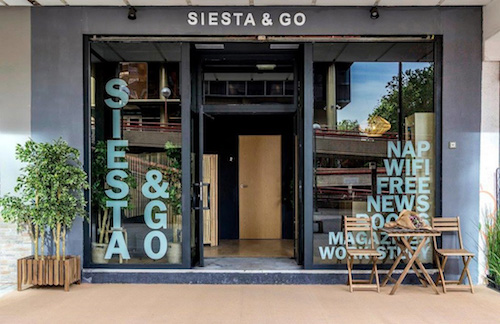
In 2017, Madrid saw the opening of Spain’s first nap bar in Azca, the Spanish capital’s financial district. Because most city workers can’t get home during the post-lunch afternoon slump, the nap bar provides private rooms (for about 14 Euro (~$14.81/hour) as well as shared rooms with bunk beds 10 Euros (~$10.58)/hour.
They also offer study nooks and cozy chairs, and if you want a shorter nap/rest time, you can book by the minute, and service includes a wake-up call!) (Germaphobes, worry not. Sheets are changed and professionally cleaned between uses.)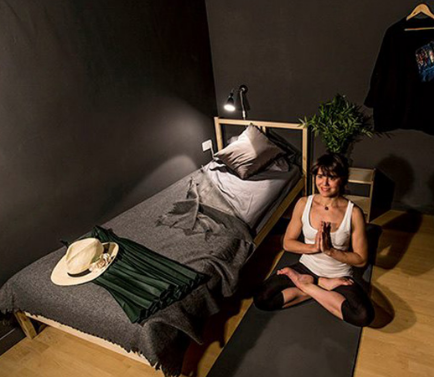
In the years since it opened, Siesta & Go has continued to expand and is now considered a hostel.
Mesimeri
In Greece, Cyprus, and many Mediterranean and Middle Eastern nations, Mesimeri refers to the midday break where businesses and offices often close for a few hours during the hottest part of the day. Mesimeri refers to the time between 2 p.m. and 5 p.m. where individuals have the opportunity to rest, relax, and enjoy a leisurely meal before resuming work later in the day.
The notion isn’t just taking a break, but that everyone is strongly encouraged to be quiet — road work and construction shuts down, and stores close. While the napping aspect of Mesimeri was practiced by almost all individuals until about 30 years ago, Greek laws still define official quiet hours where loud music and work-related noise outside are banned. It’s easy to see how these communal pauses, when everyone is allowed — even expected — to take breaks eliminates any sense of guilt about not powering through at work.
Inemuri
Culturally, it would be hard to find a productivity paradigm more at odds with Spain’s siestas, Mediterranean Mesimeri, or even France’s traditionally long lunches than Japan’s work-centric approach. In Japan, there are no formal, unified times for culturally agreed-upon rest breaks. Instead, there’s Inemuri.
Inemuri translates to “being present while sleeping,” and refers to a sort of cultural acceptance of napping in public, whether in the workplace, on public transportation, or in parks. Rather than “if you see something, say something,” in the U.S., where you might assume a dozing person is unwell, Inemuri suggests that if you see someone conked out, they are less likely to be ill or have been imbibing and more likely to be evincing signs of dedication to their employers and hard work.
Obviously, this work-til-you-drop lifestyle is not something we want to emulate, but the acceptance of Inemuri allows people to take short rest breaks throughout the day. So, at least there’s a culturally accepted practice giving workers the capacity to recharge during Japan’s excessively long work hours.
And, if you don’t feel like sleeping at your desk, there are nap cafés and even vertical nap pods available in many workplaces and cafés to grant privacy (so nobody sees you drool). For example, there’s the GiraffeNap, a TARDIS-like capsule with headrest, cushioned seat, and footrest.
If you’ve got more time to watch a TikTok influencer experience the full Janapese nap pod experience, try this:
Wu Wei
In China, the Taosist concept of Wu Wei can be translated as “non-doing” or “effortless action.” , and it emphasizes the essentiality of taking breaks in order to allowing yourself to be in harmony with the natural flow of life. Wu Wei is less of a specific break ritual, and more a way of thinking, living, and working such that society (and the work place) values time for rest and creating balance in daily activities.
For more about the power of napping and resting:
- Inemuri & Siesta — Method Behind the Madness
- Napping: Benefits and Tips
- The long-term memory benefits of a daytime nap compared with cramming
- The Pros and Cons of the Siesta
BREAKS TO EAT AND SOCIALIZE
Merienda
In Spain, Portugal, North Africa, Brazil, and The Philippines, Merienda is the practice of taking a mid-afternoon break from work or school for a light meal or snack. As you might expect, this practice is a more official opportunity granted for individuals to take a brief pause, enjoy some refreshments, and recharge before continuing with their tasks.
After all, as we discussed last week, when our blood glucose suffers, brain fog zaps our ability to learn, remember, focus, or create. A merienda meal generally consists of simple snacks (bread, fruit, yogurt) and beverages (from child-friendly milk, hot chocolate, and fruit juice to more adult-appealing coffee and even light alcoholic drinks).
In South America, particularly Uruguay, Paraguay, Argentina, and Brazil, the break is later in the day and a bit heavier, while in the Philippines, merienda culture the break for relaxation and rejuvenation comes twice a day, once in the mid-morning and again in mid-afternoon.
As long as you’re taking a break to read this post, want to make some merienda delicacies or read more about Spanish Meal Times and La Merienda — What and When to Eat?

La Merienda, or The Afternoon Meal, 1772, by Luis Meléndez, Metropolitan Museum of Art
Tea or Chai Break
Throughout the United Kingdom, places colonized by the UK over centuries, and in Asia, tea breaks for snacks (and not just the beverage tea) and socializing have been popular for the past two hundred years. The break for “a cuppa” is not merely culturally accepted, but respected, and provides the opportunity for workers and students to relax and foster social connections with their cohorts, both (as we discussed last week), improving well-being and productivity.
The equivalent of the tea break in India is the chai break, and similarly involves pausing work to enjoy a hot beverage, a snack, and some convivial conversation.
Riposo
Italy has lots of daily social rituals. La Passeggiata is a leisurely evening stroll designed to shake loose the cobwebs and stressors of the day and ease into the evening; it also gives people the chance to greet their neighbors.
Riposo is a bit of a cross between a siesta and a merienda. Many Italians practice a long riposo lunch break, closing during (varying hours) from Noon to 4 p.m. to go home (or to restaurants) and take an extended pause for lunch and quiet time. While this is less often observed these days by knowledge workers in offices, the riposo custom is still observed by stores, museums, and churches, while restaurants stay open throughout the afternoon to accommodate those not able to return home.
THE SWEDES TAKE THE CAKE FOR TAKING A BREAK
At the risk of sounding like a spokesperson for IKEA or the Swedish Tourism Board, Sweden has cornered the market on taking breaks for the betterment of everyone. They practice two break-reated concepts that are central to feelings of well-being and improved productivity.
Lillördag
Let’s start with the Nordic concept of Lillördag (pronounced lee-lur-dog), a Swedish word meaning “little Saturday.” Conceptually, it encourages breaking up the monotony of the workweek with the spirit of some weekend mojo.
Generally, Swedes practice lillördag on Wednesdays, and it often includes going out for drinks with colleagues. (When I worked in television, I found that this habit (particularly among the sales staff) was called “any day ending in a Y.” But I digress.)
Rather than being seen as a work-related obligation that might contribute to toxic productivity, lillördag generates the sense of a mini-vacaton mid-week, giving workers something to look forward to amid the drudgery of a typical workweek.
The goal is to actually combat toxic productivity, prevent burnout, and promote mental recovery. Participants are sociable, but they aren’t merely moving work-related conversations about client obligations or how annoying Carol in Accounting can be into a more convivial (or boozy) atmosphere. Rather, lillördagers (I made that up) are encouraged to avoid talking about cranky-making things and just be social.
When I first heard about lillördag, it reminded me of Laura Vanderkam’s advice in her book Tranquility by Tuesday: 9 Ways to Calm the Chaos and Make Time for What Matters about scheduling little weekly adventures!
Vanderkam found that to get out of our daily/weekly ruts, we all require more novelty, texture, and richness in our time and our tasks. Vanderkam encouraged everyone to plan life in weeks, and to identify one “big adventure” (lasting perhaps half a weekend day) and one “little adventure” (lasting an hour) each week to introduce novelty. As Vanderkam says, “We don’t ask where did the time go when we remember where the time went.”
With lillördag, the “little Saturday” break from workweek drudgery on Wednesday can enliven your spirit. But lillördag is truly little in importance when compared with Sweden’s biggest break concept: fika!
Fika
Considering that fika — a quasi mandatory (but relaxing) coffee and cake break — is so ingrained in, and important to, Swedish culture that it’s protected by law, it’s shocking that it’s not better known around the world.
The purpose of fika is not merely taking a snack break. It’s about slowing down, stepping away from work, and connecting or even bonding. Swedes do not grab a cup of coffee and a muffin from the office canteen or break room and then head back to their desks to eat.

Rather, fika breaks are designed to give people an opportunity to savor — the time away, the company, and the confections. (We’ve talked before about the importance of savoring for attending, appreciating, and enhancing positive experiences in life. If we don’t step away from our work to appreciate other aspects of life, everything turns into “All work and no play makes Jack a very dull boy.”
As you might guess from last week’s post, the Swedish taking of fika breaks is positively correlated not only with enhanced physical and emotional well-being, but also improved productivity and efficiency. Decades ago, researchers found that the most workplace accidents occurred around 10 a.m. and 3 p.m., and a practice was instituted for workers to take breaks at those two times.
The name fika, used as both a noun and verb, comes from a twisting of the letters in kaffi (coffee). It’s not about the coffee and pastries, per se, though the options are mouth-watering, such as those shown in The Culinary Art of Fika.
Fika works as a pressure valve, an opportunity not only to clear one’s head for a reset and refresh, but also an opportunity to step away from work culture. It’s considered bad manners to talk about work during fika. Instead, share a photo of your dog (or your kid), discuss everyone’s recent or upcoming vacations, or just get to know someone better.
Traditionally, fika breaks are taken in the workplace. Individual employees or work teams may take turns bringing pastries like fikabröd, Swedish for fikabread, which they either make at home or purchase from local bakeries.
And it’s not just a little square of coffee cake or a doughnut from a box! Fika is a bit of a multi-course meal, with a bit of a social protocol around the order in which things are eaten. For example, some fika folks encourage eating the yummies from least fancy to most; for example, starting with a cinnamon bun, moving on to small cookies, and ending with a Princess Cake. (Don’t worry, I didn’t know what a Princess Cake was, either.)
Carbohydrate heaven! (While fika delicacies lean toward the sweet, savory options are allowed.)
Fika is such a big deal, culturally, that a popular podcast designed to introduce Sweden to the world is called A Swedish Fika.
Fika reminds me very much of a ritual we had at my dorm at Cornell. I lived in the International Living Centre, a mix of 144 international students ranging in age from 16-year-old freshman to 30something graduate students. Campus-wide, 11 p.m. was designated the time for a “primal scream,” where students all over campus would open their windows and howl at the indignit of too many exams and problem set.
The ILC, however, took a multicultural approach to letting off steam. From 11 p.m. onward, people would drop in and fade away from the main lounge for Coffee Hour. The dorm provided coffee, tea, hot chocolate, and a rotating bevy of store-bought (and occasionally homemade) desserts, and students would wander around the room, plunking down to chat with small cliques and reapportioning themselves, comfortably leaning against the fireplace, hanging over the ends of couches, and splaying themselves on the floor.
As the nighttime waned, some folks meandered off to sleep, while most returned to their rooms, the smaller study lounges, or back to campus for late night library sessions, energized from the caffeine, sugar, and social lubrication of Coffee Hour. Now I wonder if a Swedish ILC-er started the tradition!
Are you familiar with any international cultural practices for break-taking that I didn’t mention? And which of these breaks would you most like to incorporate into your work day? Would you like to fika mid-morning? Riposo or siesta in the late afternoon?
Take a Break — How Breaks Improve Health and Productivity
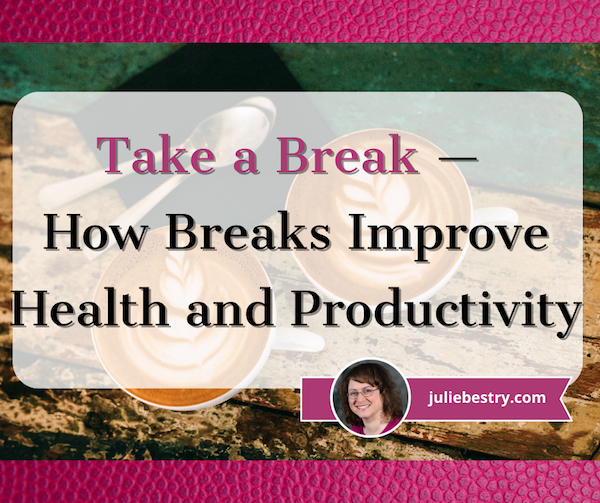
If I asked what the single best thing you could do to improve your productivity was, what would you say? Would it be doing a brain dump of your tasks? Prioritizing what you need to do? Making a list? Avoiding multi-tasking? Eliminating interruptions?
What would you think if I told you that the best way to get the most out of everything you are doing is to stop doing it for a little while?
I know, it may sound counterintuitive, but taking a break instead of spending your day trying to power through is exactly what’s needed for your body, your brain, and your spirit, not to mention the actual work.
It may sound counterintuitive, but taking a break instead of spending your day trying to power through is exactly what's needed for your body, your brain, and your spirit, not to mention the actual work. Click To TweetLet us not forget the trouble Alexander Hamilton found himself in when he failed to take a break. First, Eliza begged him to step away from his efforts to create a national banking system and pay attention to his son’s performance. (It’s a pity Lin-Manuel Miranda didn’t insert a verse from Cat’s In the Cradle!) Then his wife and sister-in-law begged him to “take a break,” and join them at their father’s place in upstate New York instead of struggling on in New York City.
(And, as fans of history and/or the musical Hamilton know, the failure to take a break from single-mindedly focusing on defeating Jefferson, et. al., and controlling the American economic future led, at least in part, to Hamilton making a poor personal decision (regarding Maria Reynolds), which led to others thinking he’d made a poor ethical and professional decision, which led to Hamilton blowing up his personal and professional lives. The whole second act is a testimonial for the vital importance of taking a break!)
But we don’t have to interpret musicals to know that taking breaks from our work or studying is essential for happy, productive lives. In “Give me a break!” A systematic review and meta-analysis on the efficacy of micro-breaks for increasing well-being and performance, researchers analyzed the results of 22 independent studies on the efficacy of work breaks for “enhancing well-being (vigor and fatigue) and performance.” They found that breaks were essential for replenishing mental and physical energy after work-related depletion, and that the more depleting a task is, the longer a duration of break is needed.
And if neither musical arts nor academic research is enough to convince you, how about the effect, not only on workers, but on work? Eight years ago, an NPR piece, We’re Not Taking Enough Lunch Breaks. Why That’s Bad For Business, noted that only one in five people were stepping out of the office at lunchtime. The point wasn’t eating at work, but not stepping away from work. As we’ll see, that undermines our bodies, our minds, and the quality of the work we perform.
WHAT COUNTS AS A BREAK?
A break can be of varying durations for varying activities. How long does a break need to be to have a positive effect? That depends on the work you’re doing, how much energy it depletes, and the kind of break you’re taking.
How to Take Better Breaks at Work, According to Research from the Harvard Business Review, notes that shorter breaks can be effective but that the timing of breaks is also vital. For example, because fatigue intensifies as the day goes on, short (or at least shorter) breaks are more effective in the morning, but by late afternoon, longer breaks are necessary to yield positive results.
So, what length breaks should we consider?
20–20–20 Rule
This rule simply instructs that every twenty minutes of screen time, look away from the screen and focus on something at least twenty feet away for at least twenty seconds.
The 20–20–20 Rule is designed to prevent computer vision syndrome, particularly digitally-induced eye strain. Taking a break like this can also help reduce blurred vision, headaches, dry eyes, and neck and shoulder pain.
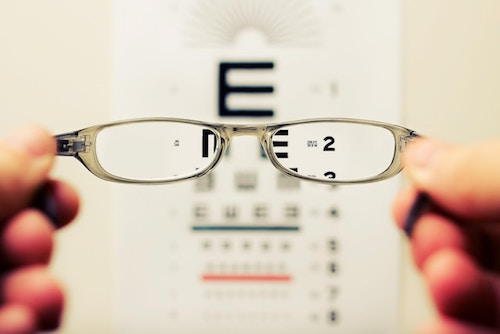
Eye Chart Photo by David Travis on Unsplash
Regular screen breaks of just one-third of a minute will give your baby blues (or browns or greens) much-needed rest, but maybe more. When something (like a phone alarm or alert on your screen telling you, “Look away! Look away!”) prompts you to take this momentary break for your vision, you’re likely to adjust more than your eyesight.
When you’ve been in flow, focused intently on what you’re reading on the screen, you’ve probably failed to pay attention to your posture (so you maybe slumped forward toward your screen) and your breathing. This super-quick break shakes everything loose.
Short Breaks
A short break would be anything that takes less than 5 or ten minutes. Consider the break you might take when doing a series of Pomodoros, where you work for 25 minutes, then step away from the task at hand — and step away from your desk — to stretch, spend a few minutes on a puzzle, or play with your puppy.
Moderate Breaks
These are the kind we’ll be looking at in great detail over this post and the next one. There’s quite a bit of cross-over between the breaks that primarily help reset the body vs. the brain, but in broad strokes, these categories might include:
Breaks primarily for the body
- Meal and snack breaks — Working through lunch is so bad for your physical and mental health that France outlawed eating at your desk all the way back in 1894! It’s called la pause déjeuner, and granted, it was for hygienic reasons, but now it’s recognized as good mental hygiene to step away to eat lunch mid-day and onboard some healthy(ish) snacks to energize the body, concentration, and focus.
- Nap breaks — Sure, not everyone is physically (or socially) able to take a power nap, but these mini-sleepytimes can pump up our energy and improve our ability to concentrate. In the US, this is more likely to be your jam if you work from home, unless your company has invested in nap pods, but there are many cultures where a nap break is considered part of the work day.
- Walk breaks — Personally, nothing allows me to refresh my brain as well as getting my 10,000+ steps. While the prescription for 10K steps was made up by a Japanese pedometer company (and your personal peak number of steps depends on age and health), there’s something magical about pounding the pavement (or the lawn or the forest). Each successive step seems to clear mental fog; if I take a walk break when I’m facing a work problem (like how to tackle a blog post), the solution comes to me by the time my walk break is over.
- Dance breaks — Pump up the jam! The advent of personal surround-sound means you can listen to music without Lloyd Dobbler standing outside your bedroom, hoisting a boom box playing “In Your Eyes” over his head. If you work alone, blast your tunes; otherwise, put on those Beats or Airpods, and play on your favorite song to make your own music video.
Find a conference room or classroom where nobody’s likely to disturb you, or head out behind the building, and shake your groove thang! Consider these suggestions for finding your go-do dance-along video:
Breaks primarily for the brain
- Meditation and mindfulness breaks — An entire industry has popped up for helping people take breaks to be mindful and/or meditate. Some popular free apps include:
- Insight Timer
- UCLA Mindful
- Healthy Minds Program
- Smiling Mind
- Mindfulness Coach (developed by the US Department of Veteran’s Affairs to help combat PTSD)
Additionally, there are a variety of guided meditations on YouTube. For example:
Whether you aim for more formal guided meditations or gentle mindfulness activities like deep breathing, you’ll find that this kind of break can reduce your stress when you feel like you’re constantly tumbling <bleep>-over-teakettle.
- Nature breaks — I’m probably the last person to think about communing with nature. I hate wind and rain and bugs and heat and the sound of frogs and crickets. I am generally an in-of-doors girl. But the Japanese practice of “forest bathing” (Shinrin-yoku) has been found to reduce blood pressure, alleviate depression, improve mental health, boost immune function, and more. Beyond that, getting away from your computer and focusing your eyeballs (and the rest of your sensory receptors) on something other than work will recharge the body and the brain, making the return to work more inviting.
And even I can find ways to enjoy nature! This past weekend, my friend and colleague Sara Skillen and I drove from our respective cities to meet at Sewanee — University of the South for lunch and a bit of a meander.
I love exploring college campus architecture, and we were both excited to walk the labyrinth in Abbo’s Alley, acres of campus with forest/woods, streams, stone bridges, a butterfly garden, gazebo, and other goodies.
We spent over an hour in search of the labyrinth (not even shown in the calming video, above), ambling (and occasionally tripping) over tree roots and wobbly rocks. However, the combination of Sara’s stellar company, perfect temperatures, and the lack of bugs made our jaunt an ideal break from the typical workweek.
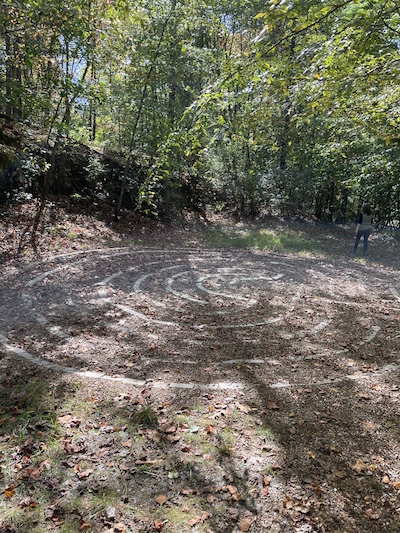
The intriguing thing is that taking a break to “touch grass” works even if you’re not walking or otherwise moving around enough to pump your blood; just sitting outside, even if your “outside” isn’t at all what most people would think of as “nature,” can still have a calming effect.
- Creativity breaks — Even if your workday involves creating, a creativity break can blow that layer of dust off of your mental capacity. You can’t usually step away from work to spend half a day creating, but you can blend your lunch break with some time for painting, drawing, playing a musical instrument, or journaling (by hand, if possible).
- Appreciation breaks — Not every break requires producing something. Sometimes, when your brain is full of one thing, the solution is to fill it with something else, particularly something serene or delightful. Consider taking your lunch break at a nearby museum or art gallery, or just watch tiny humans playing in the park. Appreciate the elegance of ducks swimming on a pond or enjoy the colors and sounds of an open air market.
- Social breaks — While reading social media has downsides, being social does not. I’m an extrovert, and there’s nothing that pumps me up more than taking a break to socialize. Of course, if you’re an introvert, you may not want to wade into loud, involved conversations with colleagues (or, heaven-forbid, strangers), because it may drain you of the mental energy you’re aiming to refresh.
Whatever kind of break you take from daily work, select types of activities that will use different aspects of your brain than you were using to write reports, design web sites, study economics, etc. This allows the “part” of the brain that was overworked to rest and re-set.
Full-Length Breaks: Vacations
I could (and probably should) write a post about the mental, physical, and productivity benefits for taking a long break, whether that’s a real weekend without looking at email or a two-week immersive vacation. Of course, not everyone gets paid vacation, but vacation-length breaks are essential to our health and vigor, which in turn, keep us productive, whether that means making the widgets to building society by raising a family (or, as is often the case, both).
THE BENEFITS OF TAKING A BREAK
When we take breaks throughout the workday, we reap the benefits of better overall physical and mental health, enhanced cognitive function, and improved job performance, all of which will improve our productivity. Let’s look at some of the key advantages of incorporating regular breaks in your work routine.
Enhanced Physical Health
When we incorporate any breaks in our day that involve physical activity or movement, whether it’s stretching, walking, or exercise, it contributes to improved physical health. We improve the blood circulation throughout our bodies (including to our brains!) while reducing the muscle tension that leads to headaches, body strain, and repetitive stress disorders like carpal tunnel syndrome.
We also prevent the various negative health effects of prolonged sedentary behavior. I’m sure you’ve heard the expression, “Sitting is the new smoking.” As I explained in Paper Doll on The Truth(s) About Standing Desks, it’s not that standing desks are that much better. Sitting is bad because when you sit all day, your telomeres (the tiny caps on the ends of DNA strands) get shorter, and the rate at which the body ages and decays speeds up. However, standing all day (like at a standing desk) isn’t necessary all that much better. What is important is movement, and you generally have to take a break from work to get moving!
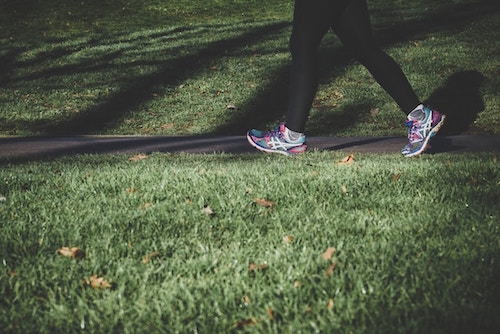
Walking Photo by Arek Adeoye on Unsplash
Stress Reduction
Varying reports note that workplace-related stress affects up to 80% of American workers. That’s estimated to cost anywhere from $150 billion to $300 billion. That economy-busting stress isn’t going to disappear if we add a few extra breaks each day for mental clarity, but we can turn this around on a personal level.
Breaks in our workday give us the opportunity to reduce stress levels and alleviate the pressure of constantly being focused on work (and the related external expectations place on us). When we engage in any kind of activity that promotes relaxation, we can lower blood pressure (which is good for both the body and the psyche), improve mood, and enhance a sense of well-being.
When we think about stress-reduction activities, we often focus on time-intensive tasks, like a yoga class or long hike, but short-term activities like mindfulness exercises, deep breathing, and brief walks (around the building or around the block) can have similar mental health benefits for reducing stress.
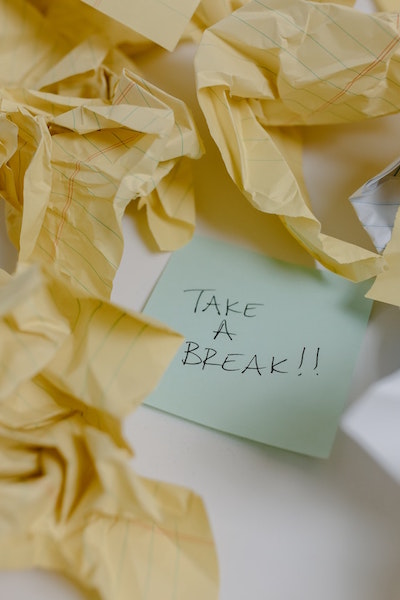
Take a Break Photo by Tara Winstead
Increased Energy and Motivation
When we take breaks throughout the workday, the physical and mental health benefits described above will have a domino effect, knocking down (and out) other problems.
When we take stop what we’re working on to eat, nap, socialize, exercise, or just remove ourselves from hyper-focus on our work, we replenish our energy, both our physical capacity (with improved blood pressure and balanced blood glucose levels) but also our mental capacity.
Conversely, if we don’t take breaks, we’re more likely to suffer from burnout. A 2022 study from Aflac found that 59% of workers were experiencing burnout, and 86% of those reported experiencing anxiety, depression, and sleep difficulties in the prior year, so this is not a negligible concern.
Setting aside time for physical movement, relaxation, and self-care boosts our sense of well-being, which tops off our enthusiasm, and in turn, that improved motivation boosts our ability to perform and sustain our productivity. Whoohoo!
Improved Focus, Memory, Concentration
Contrary to our assumptions that we should always power through our work, our brains need novelty. Researchers at the University of Illinois found that the longer we focus on something, the more likely the occurrence of a “vigilance decrement,” where our “attentional resources” start to plummet. It’s like how we are aware of how cold the ocean is when we jump in, but the longer we’re exposed, the more we get used to it. Or, to use a clichéd metaphor, we’re the frog in the boiling water.
Our brains respond to change, and the longer we go without change, the less efficient they are. Breaks don’t just rev us up; they help prevent the mental fatigue that sets in when we’ve tried to work too hard or too long. When we get lost in those mid-afternoon cobwebs, a break can enhance concentration, allowing the brain to rest and recharge.
Periods of mental rest, whether through mindfulness, activity, or sleep have the power to help us consolidate our memories and improve learning. And this is all as true for kids as for adults!
Short break periods jazz our bodies. We might imagine that a vigorous walk or dancing around to Taylor Swift would pump too much blood to our brains, making it hard to focus, but the opposite is true. Relaxation, whether it’s arrived at through calming activities like meditation or energizing ones like physical activity, will boost cognitive resources. In turn, it enables people to improve and maintain attention, allowing more effective and efficient focus on the work at hand!
Prevention of Decision Fatigue
Decision fatigue occurs when we are faced with too many overwhelming choices without adequate rest, whether for our bodies or our brains. However, breaks can play a crucial role in preventing decision fatigue; just a short pause for the right kind of physical or mental stimulation and/or relaxation can reset cognitive resources.
When we have decision fatigue, we may make poor choices, or procrastinate on making any choices at all. Breaks can give us the resilience to make better decisions and maintain a higher level of productivity, using those decisions to move our projects forward.
Enhanced Creativity and Problem-Solving
We all know what it feels like when our brains get stale. We cease coming up with fresh takes (or even fresh words), which turns into a vicious cycle. If we’re not feeling creative and can’t solve our problems, we’re going to feel bored, unenthusiastic, and stressed out!
Taking breaks fosters divergent thinking and spikes creativity, so we can approach tasks from fresh perspectives. Just stepping away from work for a short time — and focusing on the right energy-boosting replacement tasks — can stimulate more innovative ideas and solutions, improving our problem-solving skills and pumping up our creative mojo.
Per the NPR piece I quoted earlier, Kimberly Elsbach (a Professor Emerita Fellow, Academy of Management University at the California Davis Graduate School of Management), an expert in workplace psychology, noted that never leaving your office or your desk is “…really detrimental to creative thinking. It’s also detrimental to doing that rumination that’s needed for ideas to percolate and gestate and allow a person to arrive at an ‘aha’ moment.” Aha, indeed!
It’s essential to recognize the positive impact of breaks on physical, mental, and emotional well-being so that we can remember to prioritize these pauses and integrate them into our daily work routines. This is key to us fostering balanced, productive approaches to taking on our responsibilities.
Not all breaks are created equal
Pausing work to scroll through social media won’t have the same benefits as the kinds of breaks discussed earlier in this post. First, everything from the death-grip on our phones to the poor posture of arching necks over screens to the blue light of cell phones is bad for physical health; plus, you’re likely to remain just as stationary as when you were working! Beyond that, social media rarely reflects the kind of psychologically neutral or uplifting content that boosts mood or cognition.
Similarly, smoke breaks aren’t good breaks. While they may yield some social benefit, data on smoking’s physical devastation on the body and brain is clear. Moreover, research finds that smokers have thinner cerebral cortex than non-smokers. (The cerebral cortex is essential for learning and memory, so thicker tissue is better.) Smoking reduces the ability to learn and remember, key requirements for productivity!
TAKE A READING BREAK
For further reading on the importance of breaks for health and productivity, you may wish to read:
Breaks During the Workday (Michigan State University)
Give Us a Break (Compass Group)
How to Take Better Breaks at Work, According to Research (Harvard Business Review)
BETTER BREAKS AROUND THE WORLD
In full disclosure, this post started out as a look at how other cultures embrace taking breaks as part of coping with excessive workloads. Instead, this is the prequel, a what-and-why for improving your vitality and productivity with breaks. Next week’s follow-up post, Take a Break for Productivity: the International Perspective is where the real fun will be, as we look at fun and tasty examples of “take a break” culture around the world.
Spoilers: the Swedes take the cake (figuratively and literally) and first place when it comes to taking breaks!
Use the Rule of 3 to Improve Your Productivity
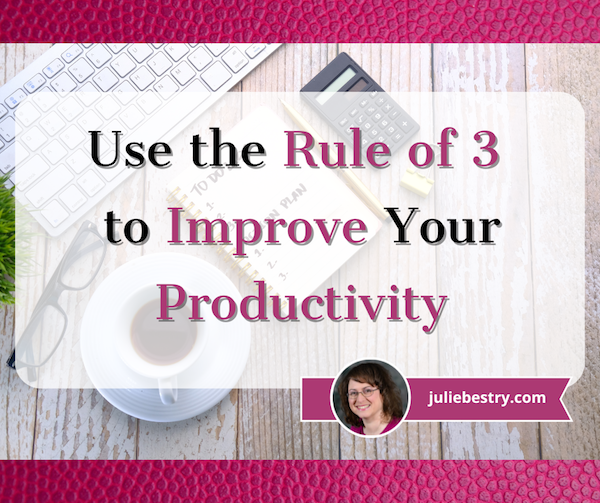
It’s Monday — the first Monday of a new month, of a new quarter, and the last quarter of the year. It may suddenly feel like a lot is riding on getting things crossed of your list so you can make those dreams come true before 2023 is in the rear-view mirror.
RECAPPING THE ESSENTIALS OF TACKLING YOUR TO-DO LIST
Back in May, in Frogs, Tomatoes, and Bees: Time Techniques to Get Things Done, we looked at a spate of productivity concepts for breaking down the hours of your (preferably time-blocked) day to effectively use your discretionary time (that is, the part of your schedule not determined by your boss, school, or firmly-scheduled obligations). We started with the essential elements of accomplishing things:
Knowing what to do — This involves a brain dump to capture every potential task stuck in your head, adding to it from everything in your various in-boxes and buckets (GTD-style), and creating a master list, whether that’s pen-on-paper or a task app.
Knowing what to do first — Prioritizing tasks involves a complex intersection of what is important and urgent. We shorthanded the process with the Eisenhower Matrix (which, as explained in Paper Doll Shares Presidential Wisdom on Productivity, wasn’t invented by the Ike we like, but was attributed to him due to a speech he gave and was made more famous by Stephen Covey).
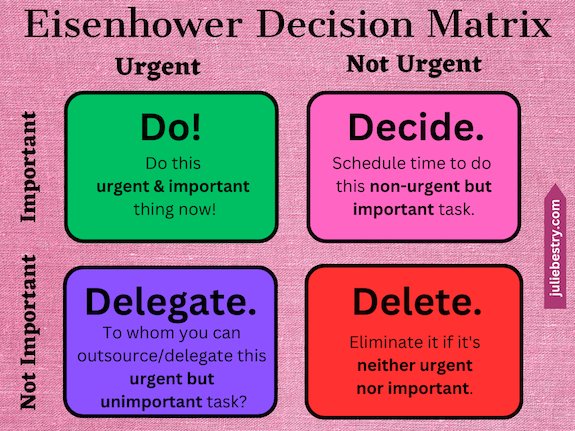
The Eisenhower Matrix gives you the opportunity to (literally or just figuratively) graph each task from your massive brain-dumped list to identify where it falls along a continuum of importance and urgency. From January through mid-April, filing your taxes is important, but it only becomes more urgent as St. Patrick’s Day is behind you and April 15th draws nearer.
Conversely, this Friday’s registration date for an adult education class on French cooking has what appears to be an urgent task; however, if learning how to make Julia Child’s famed Boeuf Bourguignon isn’t that compelling and you were only doing it to please your mother-in-law, it may fall low on the importance scale.
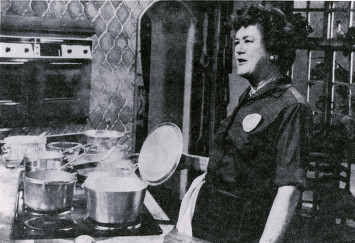 Julia Child on KUHT/By KUHT via wikimedia commons
Julia Child on KUHT/By KUHT via wikimedia commons
A big part of identifying the value of a task may involve looking at what your motivation is. You perform extrinsically-motivated behaviors in order to receive some external reward (or to avoid an external punishment). You might work at a job for a paycheck, work hard in a class to get the grades that allow you to get a scholarship, or make that Boeuf Bourguignon to keep the peace between family members (because it’s hard for people to snipe when their mouths are full).
Intrinsically-motivated behaviors are those that you do because they fulfill you personally. These include passion projects like volunteering, participating in hobbies and sports, or even simultaneously compelling but challenging life activities, like parenting.
Sometimes, you may find yourself frustrated that the very things you value for your sanity-preserving self-care are less valued by society. (This is largely because, as we discussed in our series on toxic productivity, late-stage capitalism values producing work that yields revenue, generally for the people above you in the hierarchy. Sigh.)
Of course, the ideal is to find opportunities for extrinsically- and intrinsically-motivating behaviors to dovetail. When that happens, the things that are important are easier to accomplish because they give you personal fulfillment and extrinsic rewards.
Making something a high priority, per se, doesn’t ensure that you’ll do it, but if that task is important, not just for keeping you out of debtor’s prison but also making your heart sing, you’ll do it less begrudgingly, and if it’s urgent, you’ll find you’re less likely to procrastinate.
You’re probably not going to find that your love of the game will allow you to become a professional pickleball player — more power to you if you do! — but you may find that by becoming more efficient and effective at your for-a-paycheck job will yield more free time to pursue a passion that could turn into a new livelihood.
Once you gauge your each task’s relative importance and urgency, you can move forward to knowing what to get done today (vs. delaying to later in the week), what you might delegate, and what you can hang it in the maybe/someday closet.
Do it! — The final piece of the puzzle involves making time to do what you’ve decided to accomplish.
MANAGING OUR DAYS BY MANAGING OUR HOURS
Back in that post I referenced, Frogs, Tomatoes, and Bees: Time Techniques to Get Things Done, I reviewed well-known and lesser techniques for hunkering down and getting tasks done. I encourage you to read the prior post for details of the methods you find less familiar, but in general, the post reviewed:

Pomodoro Timer by Michael Mayer CC By 2.0 Deed
- The Pomodoro Technique — At its most basic, the process involves identifying a task to work on now, setting a timer for 25 minutes, focusing on that task for 25 minutes without interruption, and taking a short break. Proponents believe it short-circuits procrastination but detractors note that it prevents getting into a flow state.
- Tocks — This variation on the Pomodoro Technique involves working 45 minutes rather than 25, and adds the step of taking note of distractions as they arise for later analysis.
- The 90-Minute Focus Block — Here, the work blocks expand to 90 minutes and the breaks extend to 20. The expanded time frame is based on research in neurobiology and how our brains use potassium and sodium ions to conduct electrical signals indicates a biological component to our ability to effectively focus.
- 52/17 Method — Splitting the difference between the traditional Pomodoro and the 90-Minute Focus Block, this accents 52-minute sprints of dedicated and intense work followed by mentally-refreshing breaks. It’s backed by behavioral analysis rather than neurobiology.
- The Flowtime Technique — This method starts like all of the others, with uninterrupted work sessions, but instead of ceasing at the behest of an alarm or other external force, you work until you start to feel distracted or mentally or physically fatigued. While this method involves a lot of administrative work for logging both distractions and statistics regarding work patterns, it’s probably the most ideal for creative endeavors, as you ignore the clock and embrace the flow.
These methods work in concert with the principles we’ve discussed regarding time blocking, particularly from these two posts:
Highlights from the 2023 Task Management & Time Blocking Summit
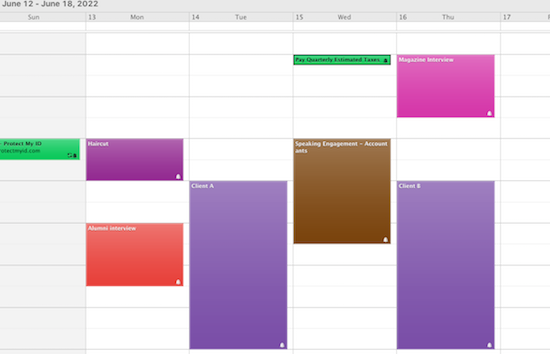
Putting it all together, you figure out what you need to do (overall), identify your priorities, and block your time to ensure ample space in your schedule for accomplishing tasks. Then you get to it!
USE THE RULE OF 3 TO KEEP LIFE FROM GETTING IN THE WAY
All of the above is great for once you get your butt in the chair and have identified a specific task, but let’s face it, getting to that point? It’s a lot.
If you work in an environment where most of your daily schedule can be firmly set in stone (or bytes) with very little to distract you, you’re lucky. But most people experience a multitude of interruptions from co-workers and bosses and tiny humans and senior parents (whether they have physical challenges or just need tech support). Others are dealing with mental and physical health crises and have limited spoons (that is, energy and capacity) to get through the day, let alone accomplish prioritized tasks.
If you’re feeling overwhelmed, there’s a productivity principle that can help you get a foothold when things feel like their going off the rails.
It’s called the Rule of 3.
At its most basic, the Rule of 3 asks you to apply your focused attention, intentionally, to three goals or main tasks for a specific time frame. Generally, and the way we’re going to examine it, that time frame is a day, but you could apply it to a week (or a four-day conference, or a working weekend) or whatever period of time you need.
The key is that you are concentrating on a small number of crucial tasks to maximize your focus, your effectiveness, and your overall productivity. The steps are simple:
Identify three key tasks.
When you plan your day, identify the three most important goals or tasks that you want to accomplish. These may all be work tasks, or they could be a combination: one key work task, one goal item for your family, and one for self-care.
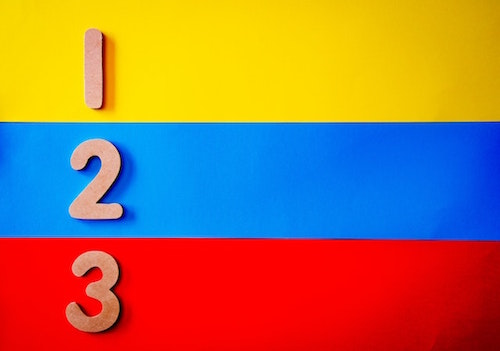
These three should be whatever you think will have the most significant impact on your personal projects, your work projects, or whatever matters the most to you.
And obviously these aren’t the only three things you’re going to get done in a day. You’re not going to skip processing email or picking your kid up from Drama Club or brushing your teeth. We ALL do more than three things in the day. But the Rule of 3 says:
Whatever else I’m doing today, I am absolutely focusing my time and attention to
GET THESE THREE GLORIOUS TASKS COMPLETED!
We’ve already talked at length about the value of the Eisenhower Matrix in prioritizing, and that’s a great place to start, but there are other concepts to help you pick your three key tasks.
Parkinson’s Law states that work expands to fill the time available for its completion. We’ve all had days where we fiddled around and didn’t start working on “the thing” until just about the time we knew we had to being in order to finish on time.
But imagine not doing that. Imagine getting the thing done. And then the next thing. And one more. Imagine not taking all the time available and just taking the time necessary.
Limiting yourself to three tasks creates a sense of urgency. If you recognize that to honor your obligation to yourself, you will focus on achieving the three key tasks, you cut procrastination off at the pass. No fiddling.
Next, experts in cognitive psychology have found that we generally have limited attention and cognitive resources. We get tired. We get bored. We get distracted. We get antsy. We get hangry. By narrowing your focus to a small number of tasks, you are able allocate your attention and mental energy more effectively, which aligns with the Rule of 3’s idea of prioritization.
Finally, Hick’s Law is a psychological principle that says that the time it takes to make a decision increases with the number and complexity of choices. Once you limit your choices for the day to just three key tasks, you are reducing the signal-to-noise ratio and the decision-making complexity. The less you must think about doing, the more you can focus on the task at hand. (And remember, you can always do more of your important (and urgent) things once you’ve done your big three!)
Commit to each of the three priorities and focus.
OK, yes, you still have three things, and you’ll have to decide which of these to do first, and second, and third. You’ll have to figure out into which time block you’ll slot each item. And then you’ll have to blur out two of them while you focus on a third.
In theory, the Rule of 3 calls on you to focus your energy and attention on completing these tasks before moving on to less critical or lower-priority activities. And obviously it discourages multitasking and giving into distractions while working toward finishing the key goals. You can use any of the focused work-session techniques listed up above once you sit down to focus on the task, but before you can focus on the tasks, you have to commit to them, to the idea that you WILL do these three key tasks today.
OK, let’s step back.
Paper Doll recognizes the need for a reality check. You will not always be able to tackle all three key tasks first before getting on with your day unless your efforts do not require the involvement of other human beings (whether tiny humans or large egos).
For example, last Friday, my car was finally ready for pickup. It’s been a long two months since it was stolen, recovered, and had to go through many, many repairs. (For reference, Organize to Prevent (or Recover From) a Car Theft tells the initial tale; everything since has been a nightmare of dropped balls, global supply chain failures, and random poopyheads.) But I also wanted to get my flu shot and had two essential financial tasks.
The car issue was actually a series of interlocking tasks. I had to confirm the specifics with the body shop, and wanted to view and approve all the work before paying my deductible and returning the rental car, which involved more phone calls and scheduling, and I needed to approve the last round of digital insurance payments.
The car goal was both important and urgent, as I didn’t want to be charged for further days of the rental car, and frankly, I missed my adorable red Kia Soul as if it were a child away at summer camp for far too long. But while most of the car’s mechanical and body work were completed, there were a few painting-related flaws, and a review of the final no-longer-estimated estimate yielded lots of new questions. However, by staying single-minded on the task and not being distracted by calls, texts, and emails, it eventually got done, and I felt an immense sense of relief and completing this key task for my day.

Getting my flu shot involved confirming that my pharmacy had the flu vaccine and that no appointment was necessary. (Last year, appointments were required and only given on certain days of the week, which often conflicted with my client schedule.) And the bank tasks, though easy, were dependent in part on the arrival of the mail, and the fill-in postal carrier did not deliver the mail until close to 6 p.m.
Celebrate your wins!
Being successful with the Rule of 3 means acknowledging completion of the task and feeling satisfaction. Far too often, we rush through what we must do without celebrating that we’ve actually done it. However, taking the time to celebrate wins improves your confidence, boosts your motivation, and will make it easier to approach other tasks (especially long-avoided ones) with verve.
For a sense of psychological benefit of this step in completing key tasks (particularly those we might define as “adulting,”) I direct you to Hazel Thornton’s recent post, High Five Friday. She explores turning this celebration of completion of key tasks from a solitary act into a social one, and as I’ve watched people follow Hazel’s lead, the evident delight people experience is palpable!
Re-evaluate, or Lather/Rinse/Repeat: The “What’s Next?” Step.
OK, so you figured out what to do, did it, and gave yourself an atta-girl or atta-boy. Now review the process. Evaluate your progress to determine the big question: what’s next?
(Fans of The West Wing recognize the power of those two words. Lin-Manuel Miranda created this video for the late, great The West Wing Weekly podcast. There are two profanities within (at :50 and 1:04), so please be forewarned.)
This is the time to evaluate your progress (and your process for getting there). Determine the next three most important tasks to focus on, whether that’s for the remainder of today, or for tomorrow, or your next key time period.
You’re creating a continuing cycle of identifying key tasks, prioritizing them, completing them, doing a happy dance and high-fiving yourself, and reevaluating what worked and what didn’t. All of this is designed to help you maintain a higher level of the good, non-toxic kind of productivity that keeps you aligned with your ultimate goals.
Why does the Rule of 3 work?
First, it’s simple, so you may actually try it. Everyone loves a new productivity technique, but the more working parts, the less likely you will be to do more than think about using it.
Second, three is a magic number.
Whether it’s “lions and tigers and bears” or “faith, hope, and charity” or if you’ve been hearing a lot about the Roman Empire lately, “friends, Romans, countrymen.” It’s easy to keep three daily priorities in your head, so if you check in with yourself at lunchtime or mid-afternoon to see how you’re doing on your goals, you can mentally measure your progress in seconds.
Finally, and most importantly, the Rule of 3 is an effective approach because it prevents the overwhelm and decision fatigue that often results from having a long, fiddly, and overwhelming to-do list.
The Rule of 3 is an effective approach because it prevents the overwhelm and decision fatigue that often results from having a long, fiddly, and overwhelming to-do list. Click To TweetNarrowing your focus to just three tasks sets you up to more efficiently allocate your time and energy, so you can accomplish more meaningful things. Again, this may be work, but could be personal enrichment or self-care. Completing a project for work may be important, but exercising and having essential medical appointments and living a fulfilled life are of inestimable importance and urgency. In other words, you matter. Paper Doll says so!
ADAPT THE RULE OF 3 TO YOUR NEEDS
As with any productivity concept, the Rule of 3 is a only guideline. There is no “boss” of the Rule of 3 in the same way that practitioners of GTD look to David Allen; indeed, I’ve done extensive research and have yet to find an originator. I originally read about the Rule of 3 almost ten years ago in Chris Bailey‘s The Productivity Project: Accomplishing More by Managing Your Time, Attention, and Energy.


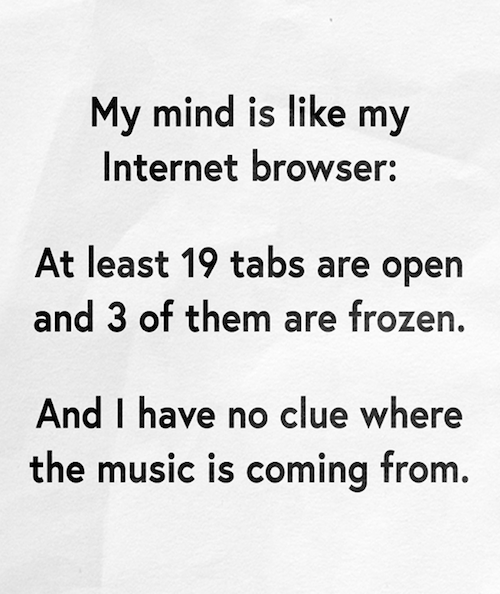
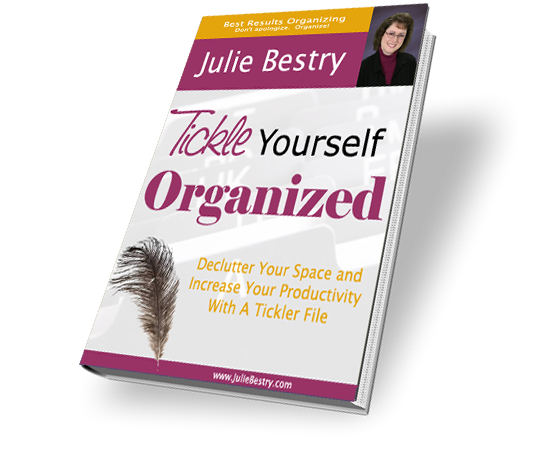
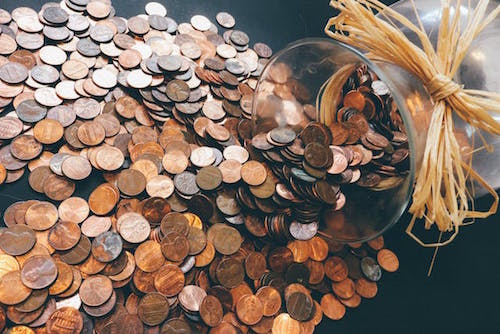









Follow Me